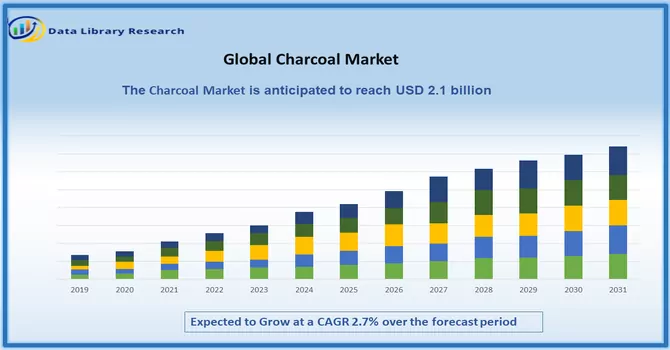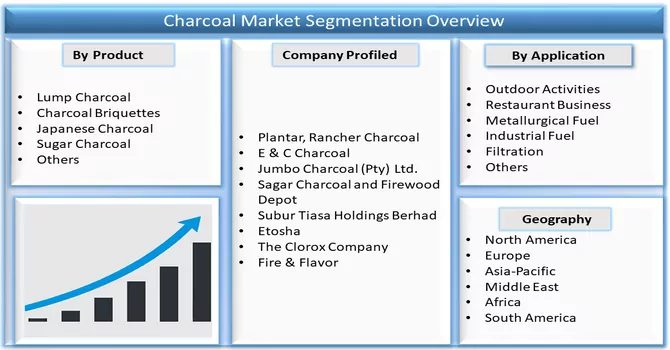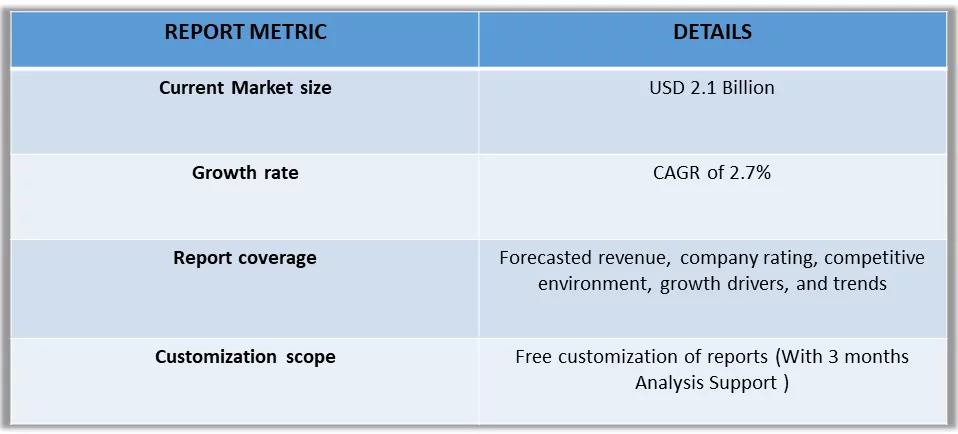The Charcoal Market Growth at a CAGR of 2.7% and is currently valued at USD 2.1 billion. It is categorized as type, product, and application by forecast period, 2024-2031.

Get Complete Analysis Of The Report- Download Free Sample PDF
In the market overview of the global charcoal market, it is evident that the industry has witnessed robust growth driven by diverse applications and evolving consumer preferences. Charcoal, derived from various sources such as wood, coconut shells, and other biomass materials, has found widespread use in cooking, industrial processes, and as a fuel source. The market has been particularly fueled by the growing popularity of outdoor cooking activities, barbecue trends, and the increasing demand for grilling products.
Moreover, the rising awareness of sustainable and eco-friendly alternatives has driven the market towards charcoal, as it is considered a renewable and carbon-neutral energy source. However, challenges such as deforestation, environmental concerns, and fluctuations in raw material prices pose restraints to the market's growth. The global charcoal market is navigating a dynamic landscape, balancing consumer preferences, environmental sustainability, and regulatory considerations to meet the demands of a diverse and discerning market. The growth of the global charcoal market is primarily driven by the increasing demand for sustainable and eco-friendly fuel alternatives. Charcoal, derived from renewable sources such as wood, coconut shells, and biomass materials, has gained prominence as a cleaner-burning fuel compared to traditional alternatives. Rising awareness of environmental sustainability and the carbon-neutral nature of charcoal contribute to its popularity. Additionally, the surge in outdoor cooking activities, barbecue trends, and the versatility of charcoal as a fuel source across industrial applications further fuel market growth. The global charcoal market is propelled by the ongoing shift towards greener alternatives and the multifaceted utility of charcoal in meeting diverse consumer needs.
Market Segmentation: The Global Charcoal Market, By Product (Lump Charcoal, Charcoal Briquettes, Japanese Charcoal, Sugar Charcoal and Others), and Geography (North America, Europe, Asia-Pacific, Latin America, Middle East & Africa). The market size and forecasts are provided in terms of value (in USD million) for all the above segments.

For Detailed Market Segmentation - Download Free Sample PDF
The global charcoal market is witnessing several notable trends shaping its landscape. One key trend is the increasing popularity of activated charcoal in various applications, including water purification, cosmetics, and pharmaceuticals, owing to its adsorption properties. Consumers are also leaning towards sustainable and ethically sourced charcoal products, driving the demand for certifications such as FSC (Forest Stewardship Council) that ensure responsible forestry practices. Another trend is the rising adoption of coconut shell charcoal, considered a more sustainable and eco-friendly option, aligning with the growing emphasis on environmental conservation. Additionally, the market is experiencing a shift towards value-added charcoal products, such as instant-light or flavored charcoals, catering to evolving consumer preferences and enhancing the overall market dynamics.
Market Drivers:
Rising Demand for Alternative Fuel Sources
The global emphasis on finding sustainable and renewable energy solutions has contributed to an increased demand for charcoal as an alternative fuel source. Charcoal's use in cooking, heating, and industrial processes has surged due to its relatively lower carbon footprint compared to traditional fossil fuels. As environmental concerns grow, consumers and industries are turning to charcoal as a cleaner and more sustainable energy option, driving the market forward.
Diverse Applications in Industries
Charcoal finds applications beyond traditional uses, such as cooking or heating, with expanding roles in diverse industries. In the pharmaceutical and cosmetic sectors, activated charcoal's adsorption properties make it a valuable ingredient. Moreover, charcoal is utilized in water purification processes to remove impurities and contaminants. The versatility of charcoal in various industries, coupled with its eco-friendly image, is propelling its demand and driving the growth of the global charcoal market.
Market Restraints:
Despite its promising growth, the global charcoal market contends with significant restraints that impede its progress. One major challenge lies in environmental sustainability concerns associated with traditional charcoal production methods. Widespread deforestation to meet the demand for wood used in charcoal production poses a threat to ecosystems and biodiversity, amplifying environmental degradation. Moreover, stringent environmental regulations aimed at mitigating deforestation and encouraging sustainable practices add complexity to the industry. Compliance with these regulations requires substantial investments in eco-friendly technologies and supply chain modifications. Additionally, the market faces competition from alternative cooking fuels like liquid petroleum gas (LPG) and electric cookstoves, driven by the growing preference for cleaner and more convenient alternatives. Navigating these challenges demands a strategic approach from market players, emphasizing sustainable practices and innovation to align with evolving environmental standards and consumer preferences.
The global charcoal market witnessed a notable impact from the COVID-19 pandemic, marked by a combination of challenges and opportunities. The initial phases of the pandemic led to disruptions in the supply chain, hampering the production and distribution of charcoal products. Lockdowns, restrictions on movement, and workforce shortages affected the operational efficiency of manufacturers. Moreover, a shift in consumer priorities during the pandemic, with a focus on essential goods, temporarily slowed demand for non-essential products like charcoal. However, as lockdowns eased and people adapted to new lifestyle patterns, there emerged a notable surge in demand for charcoal. Increased outdoor activities, home-based cooking, and the preference for backyard barbecues contributed to a resurgence in charcoal consumption. The pandemic-induced trends of at-home leisure and cooking activities played a role in revitalizing the market, prompting manufacturers to adapt strategies to meet evolving consumer behaviors and capitalize on the renewed interest in charcoal products.
Segmental Analysis:
Japanese Charcoal Segment is Expected to Witness Significant Growth Over the Forecast Period
Japanese charcoal, known as "binchotan," is a high-quality charcoal renowned for its purity and excellent properties. Made from ubame oak and processed through a meticulous burning and cooling process, binchotan is prized for its ability to burn at a high temperature with low smoke and almost no odor. This makes it ideal for grilling, where it imparts a clean, smoky flavor to food without the harshness or impurities often found in other charcoals. Beyond its culinary uses, binchotan is also valued for its purifying properties. Due to its porous structure, it is used in traditional Japanese water purification methods to absorb impurities and improve the taste of water. Binchotan is also believed to release minerals into the water, adding to its health benefits. In addition to its practical applications, binchotan is deeply ingrained in Japanese culture. It is often used in traditional tea ceremonies, where the purity of the charcoal is seen as symbolic of purity of mind and spirit. Its use in these ceremonies reflects the Japanese aesthetic of finding beauty in simplicity and natural materials. Thus, Japanese charcoal is a versatile and culturally significant product that embodies the values of purity, simplicity, and craftsmanship.
North America Region is Expected to Witness Significant Growth Over the Forecast Period
The North American charcoal market is experiencing steady growth driven by several key factors. The increasing popularity of outdoor cooking, particularly barbecuing and grilling, has boosted the demand for charcoal as a fuel source. Additionally, the rising trend of backyard entertaining and outdoor living spaces has further fueled the demand for charcoal products. One of the key drivers of growth in the North American charcoal market is the growing awareness of environmental issues and the preference for sustainable and natural products. Charcoal is seen as a more eco-friendly alternative to traditional fossil fuels due to its renewable nature and lower carbon footprint. Another factor contributing to the growth of the charcoal market in North America is the expanding range of charcoal products available. Manufacturers are introducing new and innovative charcoal products, such as flavored charcoal and charcoal briquettes infused with herbs and spices, to cater to changing consumer preferences. Despite the growth opportunities, the North American charcoal market faces challenges such as fluctuating raw material prices and increasing competition from alternative fuel sources. However, the market is expected to continue its growth trajectory, driven by the growing popularity of outdoor cooking and the increasing demand for sustainable fuel options.

Get Complete Analysis Of The Report - Download Free Sample PDF
The analyzed market exhibits a high degree of fragmentation, primarily attributable to the presence of numerous players operating on both a global and regional scale. The competitive landscape is characterized by a diverse array of companies, each contributing to the overall market dynamics. This fragmentation arises from the existence of specialized solution providers, established industry players, and emerging entrants, all vying for market share. The diversity in market participants is underscored by the adoption of various strategies aimed at expanding the company presence. On a global scale, companies within the studied market are strategically positioning themselves through aggressive expansion initiatives. This often involves entering new geographical regions, targeting untapped markets, and establishing a robust global footprint. The pursuit of global expansion is driven by the recognition of diverse market opportunities and the desire to capitalize on emerging trends and demands across different regions. Simultaneously, at the regional level, companies are tailoring their approaches to align with local market dynamics. Regional players are leveraging their understanding of specific market nuances, regulatory environments, and consumer preferences to gain a competitive edge. This regional focus allows companies to cater to the unique needs of local clientele, fostering stronger market penetration. To navigate the complexities of the fragmented market, companies are implementing a range of strategies. These strategies include investments in research and development to stay at the forefront of technological advancements, mergers and acquisitions to consolidate market share, strategic partnerships for synergies, and innovation to differentiate products and services. The adoption of such multifaceted strategies reflects the competitive nature of the market, with participants continually seeking avenues for growth and sustainability. In essence, the high fragmentation in the studied market not only signifies the diversity of players but also underscores the dynamism and competitiveness that drive ongoing strategic maneuvers. As companies explore various avenues for expansion, the market continues to evolve, presenting both challenges and opportunities for industry stakeholders.
Some of the major players operating in the charcoal market are:
Recent Development:
1) In November 2023, Ramaco Resources Inc. acquired a patent from the U.S. Department of Energy’s National Energy Technology Laboratory for a coal-to-products technology. This innovative process utilizes coal to create vehicle batteries, construction materials, and consumer products. The acquisition of this patent is the result of years of collaborative effort and signifies a major advancement in sustainable coal usage. This technology has the potential to drive the charcoal market by increasing interest in alternative fuel sources and raw materials. It could also lead to increased investment in coal-related industries. Overall, this development represents a significant opportunity for the charcoal market to expand and innovate in response to changing environmental concerns and consumer preferences.
2) In February 2024, the Kentucky Senate voted overwhelmingly to attract nuclear energy projects to a state historically reliant on coal. Senator Danny Carroll emphasized the need to diversify energy sources, including coal, natural gas, renewables, and nuclear energy. This legislation aims to prepare Kentucky for a future with a greater focus on nuclear power. The shift towards nuclear energy could impact the charcoal market by reducing coal demand and potentially prompting coal producers to explore alternative markets like charcoal production. Additionally, the transition to a more diversified energy portfolio may lead to increased interest in sustainable fuel sources, benefiting the charcoal market as a renewable and eco-friendly option. Overall, Kentucky's move towards nuclear energy has the potential to spur growth and innovation in the charcoal market.
Q1. What is the current Charcoal Market size?
As per Data Library Research the Charcoal Market Growth is currently valued at USD 2.1 billion.
Q2. At what CAGR is the market projected to grow within the forecast period?
Charcoal Market is expected to reach at a CAGR of 2.7% over the forecast period.
Q3. What are the factors driving the Charcoal Market?
Key factors that are driving the growth include the Rising Demand for Alternative Fuel Sources and Diverse Applications in Industries.
Q4. Which region has the largest share of the Charcoal Market? What are the largest region's market size and growth rate?
North America has the largest share of the market. For detailed insights on the largest region's market size and growth rate request a sample here.
Data Library Research are conducted by industry experts who offer insight on industry structure, market segmentations technology assessment and competitive landscape (CL), and penetration, as well as on emerging trends. Their analysis is based on primary interviews (~ 80%) and secondary research (~ 20%) as well as years of professional expertise in their respective industries. Adding to this, by analysing historical trends and current market positions, our analysts predict where the market will be headed for the next five years. Furthermore, the varying trends of segment & categories geographically presented are also studied and the estimated based on the primary & secondary research.
In this particular report from the supply side Data Library Research has conducted primary surveys (interviews) with the key level executives (VP, CEO’s, Marketing Director, Business Development Manager and SOFT) of the companies that active & prominent as well as the midsized organization
FIGURE 1: DLR RESEARH PROCESS

Extensive primary research was conducted to gain a deeper insight of the market and industry performance. The analysis is based on both primary and secondary research as well as years of professional expertise in the respective industries.
In addition to analysing current and historical trends, our analysts predict where the market is headed over the next five years.
It varies by segment for these categories geographically presented in the list of market tables. Speaking about this particular report we have conducted primary surveys (interviews) with the key level executives (VP, CEO’s, Marketing Director, Business Development Manager and many more) of the major players active in the market.
Secondary ResearchSecondary research was mainly used to collect and identify information useful for the extensive, technical, market-oriented, and Friend’s study of the Global Extra Neutral Alcohol. It was also used to obtain key information about major players, market classification and segmentation according to the industry trends, geographical markets, and developments related to the market and technology perspectives. For this study, analysts have gathered information from various credible sources, such as annual reports, sec filings, journals, white papers, SOFT presentations, and company web sites.
Market Size EstimationBoth, top-down and bottom-up approaches were used to estimate and validate the size of the Global market and to estimate the size of various other dependent submarkets in the overall Extra Neutral Alcohol. The key players in the market were identified through secondary research and their market contributions in the respective geographies were determined through primary and secondary research.
Forecast Model
